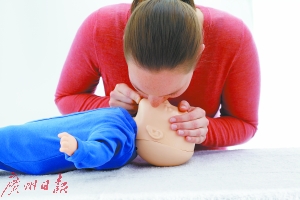First aid for drowning
Cardiopulmonary resuscitation is the first
After rescuing the drowning person, if he/she does not breathe, he/she should perform cardiopulmonary resuscitation at the first time and persist until the ambulance arrives or the drowning person is awake
Medical guidance/Lu Jianhua, director of emergency department of Guangzhou First People's Hospital, and Wang Xifu, attending physician
With the end of college entrance examination, high school entrance examination and final examination, the children's happy summer vacation is coming. However, every summer, there are reports of children drowning everywhere. A few days ago, four junior college graduates drowned just after taking the college entrance examination in Jieyang. In addition to heartache, we should reflect on how to educate our children to establish correct safety awareness when playing with water?
Experts remind that just because you can swim doesn't mean you won't drown. Parents must take good care of you. At the same time, parents should educate their children at ordinary times. In case someone falls into the water, what to do is the right way to rescue them, and exercise it properly in daily life. This is the right way to avoid drowning.
A child who can swim
Need more care
In daily life, swimming pools, bathtubs and bathtubs are the main places for children under 5 years of age to drown. Parents usually do not let young children out of their sight when accompanying them. For children who can swim, parents usually relax their vigilance. "The danger often happens in this situation," said Lu Jianhua, director of the emergency department of Guangzhou First People's Hospital.
"Let children learn to swim can not effectively prevent drowning. My child's swimming skills have far exceeded mine, but every time I take him to the swimming pool, I will follow him, because children who can swim need more care." Wang Xifu, a doctor in the city's emergency department, explained that many parents have a misconception that if their children can swim, everything will be fine, But there are many unexpected dangers and unexpected situations. "In places like reservoirs, ponds and rivers, the underwater conditions are complex, and there may be sharp stones and glass fragments under the water, which may easily puncture the swimmers' feet and legs, as well as some water plants and ropes, which may also entangle the swimmers' feet and make them unable to swim."
In addition, if the gradient of the bottom is large, and the swimmer slips from the shallow water area to the deep water area unconsciously, the leg cramp suddenly appears, which is more dangerous. In fact, in many drowning incidents of children in community swimming pools in recent years, many of them are children of six or seven years old and can swim. Many of them are accidents caused by parents' neglect of care.
Companion drowning
"Human chain" is not advisable to save people
How to rescue a child who is drowning? In many teenage drowning cases in recent years, we can see that children use the hand in hand "human chain" method to save people. Although some success has been achieved, more often it has evolved into a tragedy that rescuers have also fallen into the water, and several children drowned together.
Lu Jianhua reminded that the seemingly great idea of "human chain" to save people is actually "not to kill a person, but to kill a bunch of people". So, what should we do when we see a companion drowning? Wang Xifu pointed out that there are three principles in first aid for drowning:
1。 Never rush into the water to rescue. Parents should teach their children that even if they are good at swimming, they cannot rush into the water to save people. Because saving people in the water is a technical job, only those who have received special training to rescue drowning people are more likely to succeed. On the contrary, people without professional training are easily dragged into the water by the drowning person, which not only can not save people, but also can put themselves in danger.
2。 It is better to use equipment than bare hands. Keep calm when saving people. Don't be brave. You can choose to put life buoys, ropes, sticks, foam, etc. into the water to let the person who falls into the water climb up and help him to land.
3。 Team rescue is better than single shot rescue. To save people, it is not encouraged to be a lone hero. More people should be summoned to take appropriate rescue plans. So when someone falls into the water, the children should immediately shout for help on the shore and ask the adults nearby to help.
Rescue the drowning person
Conduct cardiopulmonary resuscitation at the first time
After the drowning person is rescued, it is also important to rescue correctly. First of all, judge the consciousness and spontaneous breathing of the drowning person. If there is no breathing, do cardiopulmonary resuscitation immediately. Don't waste time trying to drain the water from his lungs, let alone wait for the arrival of an ambulance.
Wang Xifu said: "CPR should include artificial respiration. It is better to clean the airway first and give priority to artificial respiration. During chest compression, a drowning person may have water gushing out of his mouth, but even then, do not stop the cardiac compression."
Wang Xifu cautioned that the cardiopulmonary resuscitation should not be stopped until the drowning person resumed spontaneous breathing. Even if the drowning person is rescued after a relatively long time of drowning, do not give up easily, and continue to give cardiopulmonary resuscitation. Some cases show that people who drown in cold water recover well after successful resuscitation.
In addition, all drowning people who have temporarily stopped breathing, inhaled water, or lost sexual consciousness should continue to be observed in the hospital for at least 24 hours after resuming breathing and waking up, in order to monitor whether their lung or nerve function is damaged and changed. Article/Guangzhou Daily reporter Li Heng Correspondent Huang Yuexing



